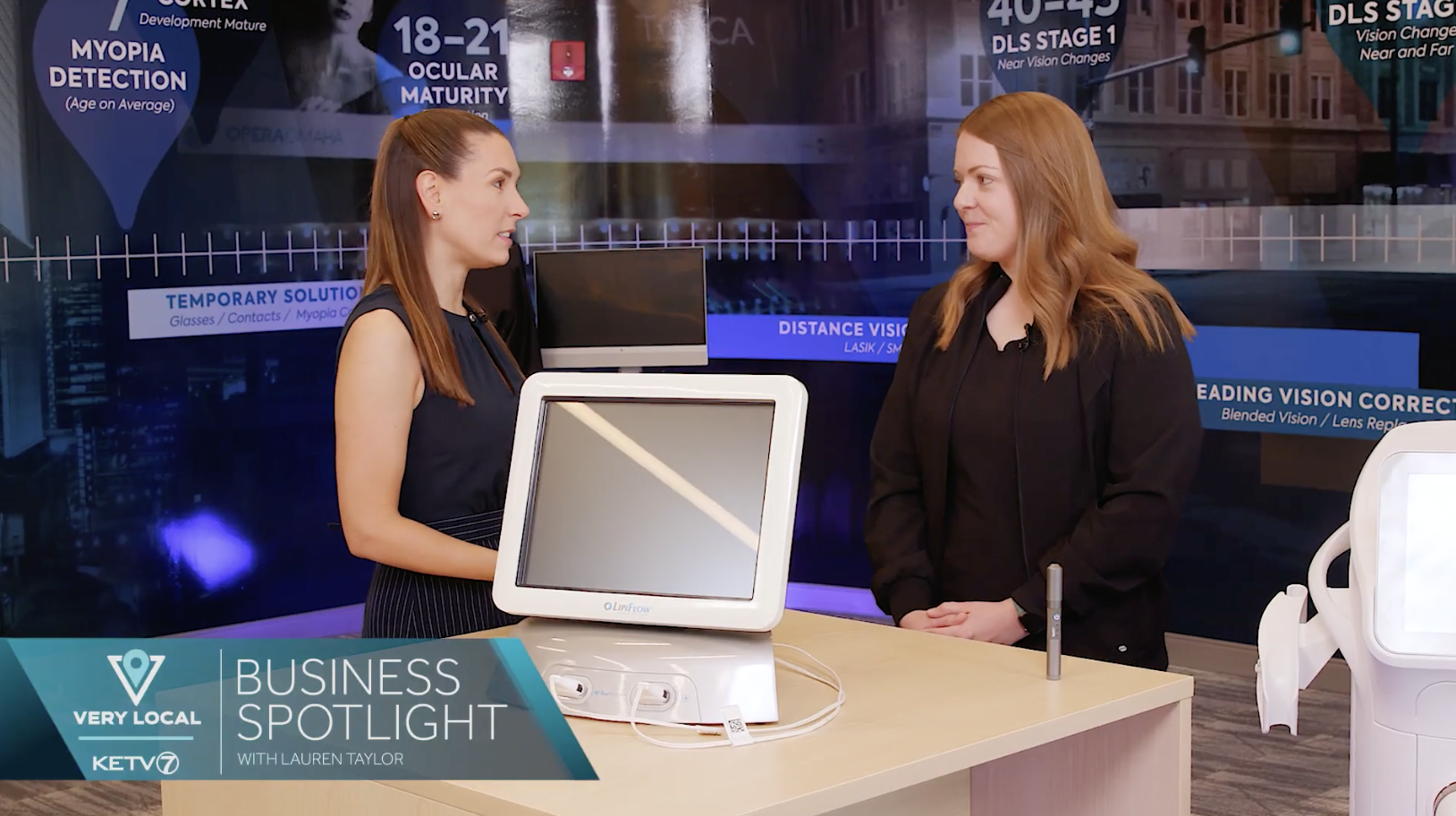If your eyes constantly feel dry, irritated, watery, or tired, you’re far from alone. Dry eye disease is one of the most common—and most misunderstood—eye conditions, affecting millions of Americans and more than 20% of people right here in Omaha.
On a recent KETV Very Local Business Spotlight, Meagan Anderson, OD, at Modern Vision Solutions shared how dry eye shows up in everyday life and why treatment requires more than just over-the-counter drops. At MVS, dry eye care is personalized, science-driven, and designed to treat the root cause, not just provide temporary relief.
Here’s what you need to know if you’re struggling with dry eye in Omaha—and how our team can help.
What Exactly Is Dry Eye Disease?
Dry eye is a chronic, progressive medical condition where the eyes don’t produce enough tears—or the tears evaporate too quickly. This leads to irritation and inflammation that can make even simple tasks like reading, driving, or using digital devices uncomfortable.
Dr. Anderson explains that patients often describe:
- A generalized dryness
- Burning
- Itching
- Watering
- Redness
- A gritty or sandy sensation
Although dry eye is typically associated with aging, it’s now affecting younger patients—including kids as young as 8 to 10—due to increased screen use, environmental factors, and changes in tear gland function.
Who Is Most Affected by Dry Eye?
While anyone can experience dry eye, some groups are at higher risk:
- Adults over 50
- Women, especially during hormonal changes
- People who wear contact lenses
- Individuals spending long hours on screens
- Those with autoimmune conditions
- Patients living or working in dry or windy environments
As Dr. Anderson highlights, dry eye is no longer “just an age thing.” It’s widespread—and often undiagnosed.
How Modern Vision Solutions Treats Dry Eye Differently
At Modern Vision Solutions, dry eye care begins with a comprehensive EyeAnalysis exam that evaluates your tear glands, eyelids, cornea, oil layer, and overall tear chemistry. From there, we build a treatment plan customized to your needs.
Dr. Anderson outlines the step-by-step approach:
At-Home Dry Eye Care
Most patients start with a foundational regimen they can use daily:
- Preservative-free artificial tears
- Warm compresses or heat masks to liquefy blocked oils
- Eyelid hygiene to reduce bacteria and debris
This builds a stable baseline for long-term healing.
In-Office Dry Eye Treatments at MVS (Omaha’s Most Advanced Options)
When at-home care isn’t enough—or if symptoms are more severe—we offer next-level in-office therapies designed to treat the underlying causes of dryness.
LipiFlow® Thermal Pulsation
A 12-minute, gentle heat + massage treatment that clears and reactivates the meibomian (oil) glands—the #1 cause of evaporative dry eye.
BlephEx® Eyelid Cleaning Treatment
A spinning micro-brush that removes bacterial biofilm, skin debris, and inflammatory buildup along the lash line.
IPL (Intense Pulsed Light) Therapy
A light-based treatment that reduces inflammation, improves oil gland function, and treats eyelid redness. IPL is especially effective for patients with rosacea-related dry eye.
Together, these therapies target dryness at the source—not just the symptoms.
Why Omaha Chooses Modern Vision Solutions for Dry Eye Treatment
Patients trust MVS because we offer:
- The most advanced diagnostic tools
- Multiple in-house treatment technologies
- A personalized plan based on your exact gland structure and tear health
- A team of dry-eye–focused providers who understand chronic symptoms
- Solutions for both everyday relief and long-term improvement
Whether you’re just starting to feel dryness or have struggled with symptoms for years, Modern Vision Solutions provides real answers—and real relief.
Get Dry Eye Relief in Omaha Today
If you’re dealing with dryness, burning, watering, or irritation, you don’t have to “just live with it.” Dry eye is treatable, and early treatment leads to better outcomes. Schedule your consultation on our website!
Video Transcript: Very Local Business Spotlight Featuring Meagan Anderson, OD
Get ready for another Very Local Business Spotlight.
Today we’re back at Modern Vision Solutions, talking to Dr. Anderson about dry eye disease.
Interviewer:
Dr. Anderson, what is dry eye disease?
Dr. Anderson:
Yes, so dryness is a chronic condition that affects a lot of our patients here. And you’ll hear just a generalized sort of dry feeling to the eyes, but also it causes burning, itching, watering, redness, all sorts of different things.
Interviewer:
And who’s most affected by dry eye?
Dr. Anderson:
Yes, so traditionally the dryness, the classic dryness patient is an older patient, but it affects over 20% of the population. So we’re even seeing it in kids as young as like eight to 10 years old.
Interviewer:
And what kinds of solutions does Modern Vision Solutions offer for patients that are suffering from dry eye?
Dr. Anderson:
So we typically will start patients on a pretty comprehensive at-home regimen. So your drops, your heat masks, but we also do a lot of in-office therapies for dryness. So this first one here is called LipiFlow. It’s a 12-minute heat and massage to the eyelids to help the oil glands work. The second one is called Blefex. It’s a spinning brush that cleans the eyelids off to get rid of any debris. And then this third one here is called IPL. It stands for Intense Pulsed Light. So it’s a light therapy that helps reduce inflammation.
Interviewer:
All right, thank you so much for your time today, Dr. Anderson.
Dr. Anderson:
Thank you.
source https://mvsvision.com/dry-eye/understanding-dry-eye-in-omaha/

 Ready to schedule your child’s school eye exam? Visit us at
Ready to schedule your child’s school eye exam? Visit us at  Eye Exams
Eye Exams